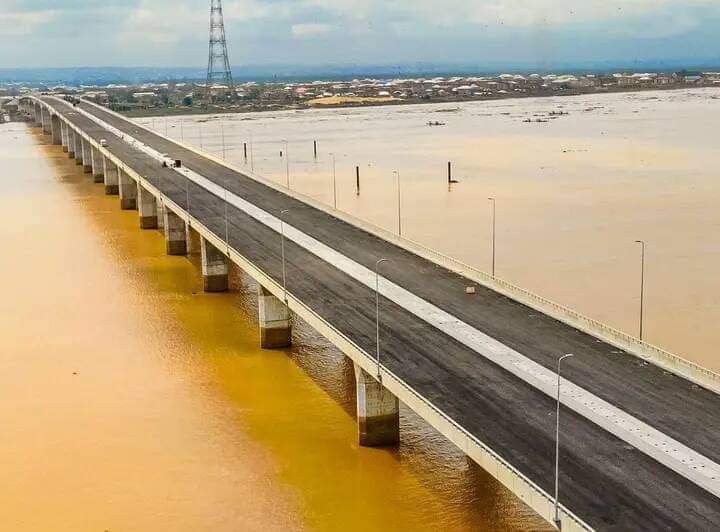The Second Niger Bridge got its name from the political campaigns of the NPN political party in the 1970s. The party proposed that they would construct a Second Niger Bridge from Asaba to Onitsha. However, on being elected, Shehu Shagari never got to fulfil the promise until his government was overthrown in 1983.
The call and the use of the idea of the bridge as a campaign promise arose due to the delapidating nature of the First Niger Bridge built in the early 1960s, and commissioned in 1965. Some politicians warned that the first Niger Bridge wasn’t enough, and there was the need of another bridge. However, it was simply at the promise level for years from the 1970s to the 2010s.
It was former President Goodluck Jonathan, who seemed serious about carrying out the project. He used it as a campaign promise, and then inaugurated the process to build the bridge. He never did, though. Goodluck Jonathan lost his re-election bid in 2015. It is the administration of Muhammadu Buhari that went on to construct the bridge.
Now, let’s take you through all the facts you need to know about the Second Niger Bridge.
All You Need to Know about it the Second Niger Bridge
1. The name Second Niger Bridge was introduced and used for it since the 1970s.
2. The plan and promise for its construction started in the administration of Shehu Shagari, passed on from over the years (over 40 years) as mere plans and promises, until it was finally built.
3. The main construction of the bridge started in 2018, and ended in 2020.
4. The Second Niger Bridge is 1.6 kilometers long, connecting the cities of Onitsha and Asaba.
5. The initial design for the bridge had a section for movement of train. The train section was later scrapped.
6. It is a public-private partnership kind of project. This means that the public will contribute heavily in the use of the bridge to pay back the private financers.
7. Thus, the bridge will be tolled when it fully becomes operational. It will be tolled until the private investors recover their money. There is only one toll gate on the road.
8. Construction of the bridge, the adjoining roads, Owerri interchange, Asaba road, toll gate, cost 336 billion naira.
9. The roads leading to the bridge from both ends that were newly constructed, and the bridge, are 46.9 kilometers long.
10. The first brigde will still be operational.
11. It was constructed by President Muhammadu Buhari’s administration. Babatunde Fashola was the Minister of Works who oversaw the starting and completion of the project.
12. Julius Berger is the construction firm that executed the project.
13. The bridge was opened first for public use on December 15, 2022.
The Economic Importance of the Second Niger Bridge for Southeast Nigeria
1. The construction and commissioning of this bridge will reduce the traffic and load on the first brigde. This means that as someone who travels to the Southeast frequently, you don’t have to worry about the stress and traffic at Niger Bridge, Onitsha.
2. It is expected that at the height of use of the bridge, more than 1000 vehicles would be using the bridge daily.
3. It will save a lot of time for commuters, especially the ones who shuttle between Asaba and Onitsha daily. The stress and traffic on the first brigde was catastrophic.
4. It will improve the state of living in the areas where it passes. This means you are to expect increased urbanization and introduction of markets along the roads linking to it.
5. It will improve the GDP and economic conditions of Delta and Anambra States as well as the surrounding states.
6. Transporters are expected to make improved income along with this route.
7. It is a good and additional source of revenue for the Federal Government, Anambra State Government, and Delta State Government.
What You Should Gain from the Second Niger Bridge?
1. If you have the money, you should get to the roads linking to the bridge to buy lands there and build. It is either you build closer to the road or in the streets. You can build for business or residential areas.
2. Start transportation businesses or logistics businesses along this route. You can have a private park of buses or siennas going to far places like Lagos and Benin, or closer places like Owerri and Asaba.
3. Start restaurant or food business along this area.
4. Start land or house agent, too. It will be a growing area so lots of lands to sell, a lot of people looking towards building houses here. It’s all about foresight.
5. You can also start other viable businesses like schools, hospitals, boreholes, buying and selling of all types of moving goods in southeast, and so on.
Conclusion
The Second Niger Bridge is indeed a blessing for the Southeast. As a resident, you should know how to earn from the construction. This bridge is so vast in use that the whole Southeast states of Delta State, Anambra State, Imo State, Ebonyi State, Enugu State, Abia State, Akwa Ibom State, Cross River State, Bayelsa State, and River State, use the bridge. The other parts of the country also use the bridge. When it is fully operational, there will be great traffic on the bridge.
